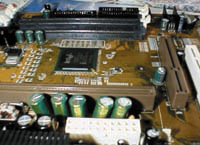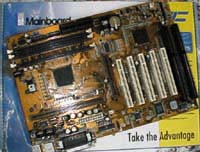FIC KL-6011 LX Pentium II Board
by Anand Lal Shimpi on October 9, 1997 9:12 AM EST- Posted in
- Motherboards
| Socket Style: | Slot - 1 |
| Chipset: | i82440LX |
| Cache: | N/A (On Chip) |
| Form Factor: | ATX (w/ AT and ATX power Connectors) |
| BUS Speeds: | 50 / 60 / 66 / 68 / 75 / 83 MHz |
| Clock Multipliers: | 2.5x / 3.0x / 3.5x / 4.0x / 4.5x / 5.0x / 5.5x |
| Voltages Supported: | 1.5v - 3.5v (Auto Detect) |
| RAM Slots: | 3 168pin DIMM Slots (SDRAM) |
| AGP/PCI/ISA Slots: | 1 AGP Slot 5 PCI Slots 2 ISA Slots (1 Shared / 2 Full Length) |
| BIOS: | AMI BIOS w/ Jumperless Bus Speed Setup |
| PCI EIDE Controller: | Super I/O 2 EIDE Channels 1 FDD Channel 2 Serial /1 EPP |
|
When looking at the KL-6011 for the first time you are shocked by the amount and size of the capacitors on the board. Immediately the rock solid stability of the KL-6011 is spoken for by the ingenious design of the board, something which is rare in the hardware world today. Since the KL-6011 is the first LX based Pentium II board to enter my testing lab I had no choice but to compare it not only to its FX based brother, the KN-6010, but the reigning champ, the Megatrends FX83-A. |
Setting the jumpers on the KL-6011 is not a task at all, 4 simple jumpers, all fully documented for, both in the manual and on the board itself. Unlike the FX8-3A, the KL-6011 uses a much more convenient baby ATX form factor and is a snug fit with my Enlight 7230 ATX case. The thing that confused me the most about the KL-6011, was that the jumper settings only corresponded to the final CPU clock speed and clock multiplier. Neither the manual nor the motherboard even mention the jumper settings for bus speeds which struck me as being very odd, I soon found out why this was so. Upon firing up the test system, which was a Pentium II at 300MHz and a Quantum Fireball ST to take advantage of the UltraDMA support of the LX chipset, I quickly noticed the oh-so-familiar look of the standard AMI BIOS startup logo. I should warn all of you now that AMI's normal BIOS Setup Utility is nothing like their WinBIOS, so don't expect a cute little GUI interface to greet you, just a plain old text based interface. The BIOS Setup is fairly self explanatory, it contains all of the basics plus a few more convenient options. One feature of the KL-6011's setup I really enjoyed is the System Monitoring portion of the BIOS's setup. The KL-6011 has the ability to monitor almost any aspect of your system from your CPU to your hard drive(s) which is a feature often seen in ASUS 97 series boards. Earlier I mentioned that I couldn't find any settings for the bus speeds, well, there is a reason for that, the FIC KL-6011 has a jumperless bus speed setup!!! Under the Advanced Chipset Setup you have the power to choose your bus speed from an extensive list ranging from 50.0MHz to 83.38MHz and also including the 68MHz turbo frequency setting for those of you hesitant to do some "serious" overclocking. Recently it seems like manufacturers are beginning to realize that with the Pentium II a jumperless CPU setup is a very simple task to achieve since you don't have to mess with multiple voltages like in the case of Socket-7 motherboards.

Here is a picture of the larger of two chips making up the LX chipset. This is one HUGE chip!!! It is about the size of a 386 DX (if you remember what a 386DX looks like) or possibly a smaller 486 SX. Click on it to view a larger image, in the larger image notice the word "SECRET" printed underneath the Intel logo...hmnn...=)
Now lets get to the performance...
The FIC KL-6011 is the only board I have tested that boasted the accomplishment of actually BEATING the Megatrends FX83-A! At all clock speeds, from 233 to 337.5MHz, the KL-6011 consistently outperformed the FC83-S in both the Business and High End Business Winstone tests by about 0.4 Winstone points. Although that isn't a tremendous increase in performance it is a hint as to what kind of performance we can expect from 2nd and 3rd generation LX based motherboards.
The stability of this board is truly outstanding, I never expected it to be this solid of a performer. What do I mean by solid? Well, for example, at 338MHz (75 x 4.5) the system never crashed or even gave me one compatibility problem. Unlike the FX83-A, the KL-6011's 83MHz bus speed option works perfectly even with my SCSI drive!!! However the fastest overall setting is currently 75 x 4.5 for 338MHz.

Here is a picture of the Pentium II - Slot 1 (bottom), the tiny AGP Slot (right), and the 3 DIMM Sockets (top).
Overall, the KL-6011 is a very well designed motherboard supporting the Ultra DMA (33MB/S) Protocol, SDRAM, AGP, as well as tremendous support for future processors including the highly anticipated Pentium II - 300 and 333.
Ok, here is where I have to express my problems with the "ingenious" design of this motherboard, FIC, I hope you're listening =)
Don't get me wrong, I love this board, it is fast, stable and reliable, HOWEVER, a major problem the KL-6011 flaunts is its lack of expansion options. Sure, having 1 AGP Slot and 5 PCI slots is great, but how about a horrible 2 ISA slots?!? That is barely enough room to fit a sound card and a modem in! I didn't even mention the fact that one of those 2 ISA slots are shared so don't expect to be able to fill up those PCI slots completely since you will most likely need more than 1 free ISA slot unless you have a PCI soundcard or something. Well, maybe I over-reacted, 2 ISA slots I can live with, but 3 DIMM slots? No, I draw the line here, 3 DIMM slots is in no way enough to compliment the power of the Pentium II and the LX chipset. With a maximum of 192MB RAM the KL-6011 rounds itself out as an excellent motherboard, with a few flaws, it really depends on the type of user you are.
Allows user to enable/disable VGA IRQ
Allows user to individually assign IRQs to PCI/Legacy ISA devices
Autodetects PnP Peripherals after POST
Coming Soon!
In recent times, choosing a motherboard cannot be completely determined by a Winstone score. Now, many boards come within one Winstone point of each other and therefore the need to benchmark boards against each other falls. Therefore you shouldn't base your decision entirely on the benchmarks you see here, but also on the technical features and advantages of this particular board, seeing as that will probably make the greatest difference in your overall experience.
I will be posting benchmarks with an ATI AGP card as soon as I get it in later this week, for now all the benchmarks were performed using a Matrox Millennium II.
Test Configuration
| Processor(s): | Intel Pentium II - 266 (512K) |
| RAM: | 2 - 32MB Megatrends SDRAM DIMMs |
| Hard Drive(s): | Quantum Fireball ST 3.2GB UltraATA |
| Video Card: | Matrox Millennium II (4MB WRAM) |
| Busmaster EIDE Drivers: | Intel v3.01 |
| Video Card Drivers: | MGA Millennium 4.03.00.3410 |
| OS: | Windows 95 Service Release 2 |
| Cooling Configuration: | Enlight 7230 Mid
Tower ATX Case 2 Secondary Case Fans OEM Pentium II Heatsink |
Windows 95 Performance of the KL-6011
| CPU | Business Graphics Winmark 97 | High End Winstone 97 |
| Intel Pentium II - 233 | 63.1 | 31.4 |
Intel Pentium II - 266 |
64.8 |
33.0 |
Intel Pentium II - 300 |
66.2 |
34.9 |
Intel Pentium II - 306 |
66.7 |
35.1 |
Intel Pentium II - 332 |
66.8 |
35.1 |
Intel Pentium II - 337.8 |
67.2 |
35.8 |
WOW...Need I say more?
Video Performance of the KL-6011
| CPU | Business Graphics Winmark 97 |
Intel Pentium II - 300 |
136 |
Intel Pentium II - 332 |
137 |
Intel Pentium II - 337.8 |
143 |
The video performance of the KL-6011 isn't nearly as high as the Megatrends FX83-A, however I'm sure that will change if I test it with an AGP card. Check back later this week for more info on my AGP tests.
Well, I can't really say anything general about the current LX boards out since the KL-6011 is the first one I've ever tested, however I can say this, don't expect the first wave of LX boards to provide blistering performance, more like a small jump in performance. If you absolutely must have a Pentium II board tomorrow, go ahead and grab this one (if you can find one that is), otherwise, hang in there. Megatrends might reclaim their title with their upcoming LX83, the successor to the FX83-A. Until then, a number of manufacturers have the option of stepping up and grabbing the gold.











0 Comments
View All Comments